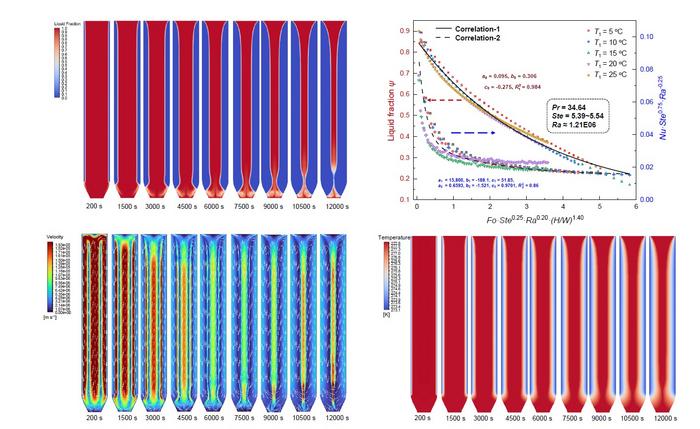In the realm of chemical engineering, the production of high-purity dimethyl carbonate (DMC) stands out as a critical process, leveraged for its applications in lithium-ion battery electrolytes, pharmaceuticals, and advanced polymers. Achieving a purity level of 99.95% or greater is essential to meet the rigorous standards set by industries demanding high-quality components. Conventional crystallization methods, while useful, fall short in balancing purity and yield, often hampered by complex heat and mass transfer dynamics that can lead to inconsistent crystal formation and reduced outputs.
Recent innovations from a dedicated research team at Tianjin University, specifically at the National Engineering Research Center of Industrial Crystallization Technology, highlight a significant leap in understanding these complex challenges. Their work revolves around a cutting-edge computational model that elucidates the crystallization dynamics of DMC. This pioneering approach marries computational fluid dynamics (CFD) simulations with rigorous experimental data, providing a comprehensive look into how natural convection influences the formation of DMC crystal layers.
Natural convection, a process resulting from fluid movement caused by temperature differences, has far-reaching implications for crystallization outcomes. The Tianjin University team’s groundbreaking research reveals that this process significantly shapes the distribution of DMC crystal layers. The insights garnered from their simulations indicate that uneven heating can lead to suboptimal production yields, a critical hurdle in scaling up DMC production for industrial uses.
The lead author of the study, Professor Hongxun Hao, explained the significance of their findings, specifically the dynamic heating strategies introduced in their research. By carefully adjusting the temperature gradients along the crystallizer walls, researchers can foster conditions conducive to both rapid crystal growth and enhanced yields. This delicate balancing act represents a significant advancement in crystallization technology, bridging theoretical knowledge with practical applications.
By quantifying the interplay between fluid dynamics and thermal gradients, the team opens the door to more tailored crystallization processes for various materials. This adaptability is particularly beneficial in commercial settings, where minimizing energy consumption and production time are paramount without sacrificing the integrity and quality of the final product. Their computational framework stands as a promising tool, allowing for strategic modifications to conventional processes.
Moreover, the researchers put forth a predictive correlation linking essential variables such as crystallization time, crystal yield, and heat transfer coefficients. This relationship serves as a crucial guideline for designing and optimizing melt crystallization procedures, thus enhancing production efficiency across various chemical sectors. The research has laid the groundwork for potential applications that extend beyond DMC, offering a robust methodology for purifying thermally sensitive materials, including organic semiconductors and pharmaceutical intermediates.
Laboratory-scale experiments have validated the proposed computational framework, confirming its feasibility and effectiveness in real-world applications. With industry standards continually evolving towards increase efficiency and sustainability, the ramifications of this research are both timely and impactful. As industries aggressively seek cleaner and more efficient production methods, this study offers a cost-effective pathway towards large-scale melt crystallization.
The implications of this research stretch into multiple domains, from energy-conscious manufacturing practices to sustainability-focused production processes. The innovative techniques developed could very well revolutionize how industries approach DMC manufacturing, setting new benchmarks for purity and yield that were previously thought unattainable. As businesses and researchers alike strive for greater efficacy in the production of chemical compounds, the insights from Tianjin University provide a beacon of hope.
Furthermore, the methodological advances highlighted in the study encourage a broader discourse on the future of crystallization technologies. The coupling of theoretical models with experimental validation not only enhances our understanding of physical phenomena but also serves as an exemplar for future research efforts across various scientific fields. As the landscape of chemical production evolves, collaborative efforts like this are essential for driving innovation.
As industries begin to embrace these new models and methodologies, they will pave the way for advancements in eco-friendly practices, transforming the conversation surrounding chemical production. The work at Tianjin University epitomizes how academic research can directly inform industrial practices, leading to breakthroughs that benefit both scientists and manufacturers alike.
In conclusion, the comprehensive exploration of DMC crystallization dynamics by the Tianjin University team exemplifies the critical intersection of theoretical research and practical application in chemical engineering. By providing a nuanced understanding of how natural convection interacts with heat transfer, their findings not only advance the scientific community’s knowledge but also support industries aiming for sustainable practices in chemical production. As further research emerges, it will undoubtedly continue to highlight the profound impact of computational methods in engineering disciplines.
Subject of Research: Not applicable
Article Title: Numerical Simulation and Optimization of Dimethyl Carbonate Melt Crystallization Based on Computational Fluid Dynamics
News Publication Date: Not provided
Web References: Not provided
References: Not provided
Image Credits: Hongxun Hao, et al.
Keywords
Applied sciences and engineering, Chemical engineering, Computer science, Biomedical engineering, Environmental engineering
Tags: advanced polymer applicationsCFD model for chemical engineeringcomputational fluid dynamics in chemistrycrystallization dynamics researchdimethyl carbonate productioneco-friendly high-purity chemicalshigh-quality chemical standardsindustrial crystallization technologylithium-ion battery electrolytesnatural convection in crystallizationoptimizing crystal formation processesTianjin University research





